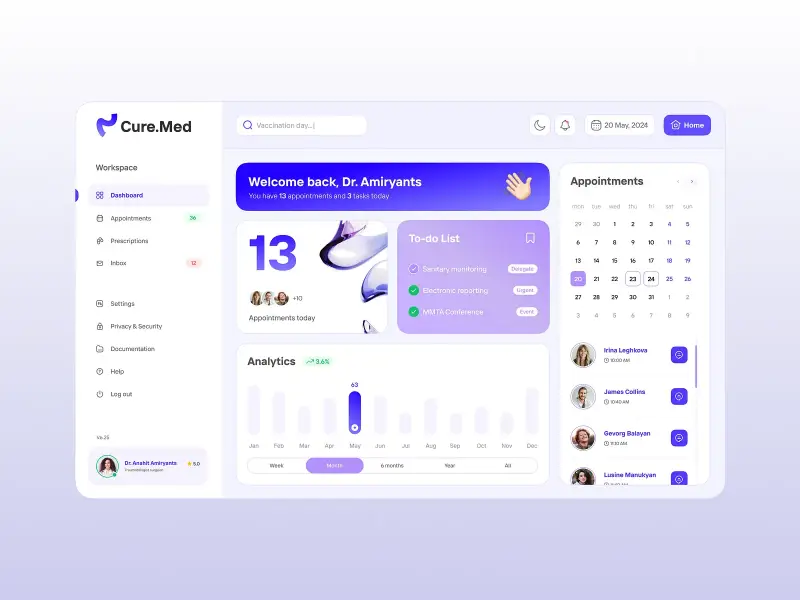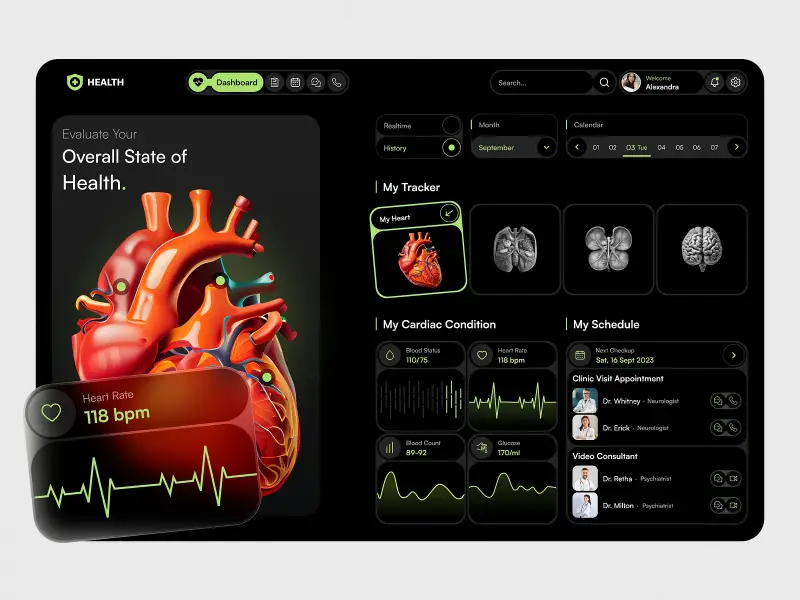Electronic Medical Record Systems List for Faster Workflow
- David Ho
- 0 Comments
Healthcare is changing fast. More and more, clinics and hospitals are turning to digital tools to stay organized, improve patient care, and save time. One of the biggest game changers in this shift is the use of electronic medical records, or EMR systems.
An EMR system is like a digital filing cabinet for your practice. It helps you keep track of patient histories, manage appointments, send prescriptions, and even connect with patients through telehealth. But with so many options out there, choosing the right one can feel overwhelming.
That’s why we’ve put together this detailed electronic medical record systems list. Whether you’re running a busy hospital or a small private clinic, this guide will help you find the best EMR software for your needs in 2025. We’ll walk you through the top systems available this year and show you what makes each one special, from user-friendly layouts to tools that save you time and improve your workflow.
Let’s take a quick look at what you can expect.
TL;DR
Electronic Medical Records (EMR) systems are transforming healthcare in 2025 by streamlining patient data, improving care quality, and reducing errors. This blog provides a complete electronic medical records software list, including top-performing platforms like Epic, Cerner, and Athenahealth, as well as specialized tools like SPRY PT.
You’ll also find a list of EMR systems in healthcare, best practices for implementation, and tips on choosing the right system based on your practice size, goals, and budget. Whether you’re exploring the names of electronic medical record systems or starting from scratch, this guide simplifies your decision-making process.
EMR Software in 2025: Best Uses, Smart Practices, and Why It Matters
Electronic Medical Records software has become an essential part of modern healthcare. It’s more than just a digital version of a paper chart. When used well, EMR software can help you care for patients more effectively, reduce mistakes, and make your day-to-day work easier.
Let’s talk about how EMR systems are helping medical teams in 2025, what best practices you should follow, and why these systems matter more than ever.
Electronic medical records software list
Best Uses of EMR Software
EMR software is designed to make managing patient information smoother and more reliable. It replaces paper files with organized digital records, so you can quickly access medical histories, test results, and treatment plans. This not only saves time but also reduces the chances of losing important information.
It also supports better care by offering tools that help you make smart, data-based decisions. Some systems can even alert you to potential health risks or suggest treatment options. Plus, EMRs simplify billing, reduce mistakes, and help you stay compliant with healthcare regulations like HIPAA.
Best Practices for Using EMR
To get the most from your EMR, it’s important that your team knows how to use it well. Training that matches each person’s role helps reduce errors and makes daily tasks faster and easier. When your staff feels confident, the whole system works better.
You should also tailor the EMR to fit how your practice works. That means adjusting templates, reports, and workflows so everything feels natural. If your EMR can connect with other systems like labs or pharmacies, that’s even better — it saves time and improves care coordination.
Why EMR Software Matters
EMR systems help healthcare providers work more efficiently by automating everyday tasks like charting, scheduling, and billing. This means more time can be spent with patients and less time on paperwork. Real-time updates also mean fewer errors and better accuracy in patient records.
They also help build trust between patients and providers. With tools like secure messaging and online portals, patients feel more involved in their care. And since EMRs support secure data handling, they help you stay compliant and protect sensitive information every step of the way.
Learn More On:
Top 10 Electronic Medical Records (EMR) Software Systems for 2025
As healthcare continues to shift toward digital solutions, EMR systems play a central role in improving how patient care is delivered. This list of EMR systems in healthcare showcases platforms that help providers manage records, streamline workflows, and stay compliant with industry regulations. Below is an updated electronic medical records software list featuring the top EMR solutions making a big impact in 2025.
1. SPRY PT
Founded: 2021
Pricing: Starting at $100/month
SPRY PT is a modern EMR solution designed specifically for physical therapy clinics. It’s built with simplicity in mind, offering an intuitive interface that helps physical therapists, occupational therapists, and speech-language pathologists manage their work more efficiently.
It includes built-in billing tools, customizable reports, and smart documentation features that reduce errors and support HIPAA compliance. SPRY PT is a great fit for growing practices that want a system tailored to their unique needs while keeping things easy and future-ready.
2. Epic Systems
Founded: 1979
Pricing: Contact for pricing
Epic is one of the most well-known EMR platforms in the healthcare world. Trusted by hospitals and large medical groups, it offers a comprehensive system that supports a wide range of specialties and care settings.
What sets Epic apart is its seamless integration with other tools and systems. It also enhances patient engagement with features like secure messaging and online access to records. Its strong analytics features help providers make smarter, data-driven decisions while keeping workflows flexible and customizable.
3. Cerner (Oracle Health)
Pricing: Starting at $25/month
Now part of Oracle Health, Cerner offers one of the most advanced cloud-based EMR systems available today. It’s designed to support large healthcare organizations with tools that make data sharing seamless and care delivery more efficient.
With strong security measures in place, Cerner helps protect patient information while offering customizable features to fit different specialties. Its reputation for innovation and smooth integration with other systems makes it a reliable choice for practices looking to scale and modernize.
List of EMR systems in healthcare
4. eClinicalWorks
Founded: 1999
Pricing: Starting at $449/month
eClinicalWorks is a robust EMR platform built to simplify healthcare workflows and improve patient care. Its cloud-based design supports practices of all sizes, offering flexibility and customization to suit different clinical needs.
Key features include easy patient self-scheduling, secure messaging, and telehealth support. With built-in AI tools and advanced analytics, providers can document more efficiently and make smarter decisions. It’s also earned high praise for user satisfaction and performance in industry rankings.
5. Athenahealth
Pricing: Starting at $140/month
Athenahealth is a cloud-based EMR platform known for its simplicity, speed, and powerful features. It’s a great choice for practices that want a scalable solution without the steep learning curve, offering smooth navigation and time-saving automation.
With tools for telehealth, patient messaging, and real-time performance insights, Athenahealth helps providers stay connected and informed. Automated reports and built-in analytics also make it easier for teams to track progress and make smart clinical and operational decisions.
6. NextGen Healthcare
Founded: 1976
Pricing: $110/month
NextGen Healthcare focuses on ambulatory care, offering tools that help small and mid-sized practices run more efficiently. It brings together EHR and practice management features into one integrated system, helping streamline both clinical and administrative tasks.
With automated reporting, secure patient portals, and telehealth capabilities, NextGen supports better communication and accessibility. Its long-standing reputation and multiple industry awards make it a trusted choice for practices looking for a dependable, all-in-one solution.
Have a Project Idea in Mind?
Get in touch with experts for a free consultation. We’ll help you decide on next steps, explain how the development process is organized, and provide you with a free project estimate.
7. Kareo
Pricing: Starting at $150/month
Kareo is built specifically for independent medical practices, offering a cloud-based EMR that combines EHR, billing, and patient engagement tools into a single, easy-to-use platform. Its clean interface and helpful features make it ideal for small teams.
The software supports virtual visits, automated note-taking, and secure messaging, giving both providers and patients a smooth, connected experience. Kareo is frequently praised for its user-friendliness and has been recognized as a top EMR for smaller practices.
8. DrChrono
Founded: 2009
Pricing: Starting at $199/month
DrChrono is a highly flexible EMR solution ideal for small to mid-sized practices. Its strength lies in its customization options, allowing providers to tailor the platform to their specific workflow and specialty needs.
With built-in telemedicine, secure patient portals, and integrated billing, DrChrono makes it easy to manage appointments, virtual visits, and payments all in one place. It’s especially popular with practices that want a modern, mobile-friendly system that adapts to how they work.
9. CareCloud
Pricing: $349/month
CareCloud offers a sleek, cloud-based EMR and practice management system that combines powerful clinical tools with smart business insights. It’s designed to help practices operate more efficiently while improving the patient experience.
From customizable documentation to real-time analytics, CareCloud gives providers what they need to make informed decisions. It also supports telemedicine and integrates seamlessly with billing tools, making it a strong choice for practices focused on growth and innovation.
10. Praxis EMR
Pricing: $259/month
Praxis EMR stands out with its AI-driven Concept Processing technology, which learns how each provider documents care and adapts accordingly. This approach helps speed up charting and enhances accuracy over time.
Its personalized workflows, simple design, and advanced reporting tools make Praxis a favorite among providers who want a system that gets smarter the more they use it. It’s both cloud- and server-based, MACRA-certified, and praised for its user satisfaction and efficiency.
Learn More On:
How to Choose the Right EHR/EMR System
Choosing an electronic health or medical record system is a big step toward improving how your practice runs. The right platform can help simplify everyday tasks, boost efficiency, and improve patient care. Here’s how to make a confident, well-informed choice for your healthcare organization.
Names of electronic medical record systems
- Understand Your Practice’s Needs
Start by identifying your practice’s size, specialty, and goals. Outline your top priorities—whether it’s faster charting, better billing, or smoother communication—and look for systems that align with those needs. - Focus on Features and Functionality
Make a list of the features you need most, like e-prescribing, telehealth, or patient portals. Prioritize them, then research systems that offer those features in a way that fits your workflow. - Integration and Interoperability
Your EHR should work well with your existing tools and allow seamless data sharing across different healthcare systems. Interoperability ensures better coordination and reduces redundant work. - Research the Vendor
Look into the company behind the software. Choose a vendor with a solid track record, good reviews, and proven experience in your specialty to ensure long-term support and reliability. - Request Trials and Demos
Always test the software before committing. Demos and free trials help you understand how intuitive the system is and whether it fits naturally into your day-to-day operations. - Prioritize Compliance and Security
Make sure the system is HIPAA-compliant and meets industry certifications. Strong data protection features are essential for keeping patient information secure and meeting legal requirements. - Think About Scalability and Flexibility
Choose a system that can grow with your practice. Whether you’re hiring new staff or adding services, your EHR should be able to adapt without needing a complete overhaul. - Evaluate Customer Support
Reliable customer service is crucial. Look for vendors that offer responsive support via phone, chat, or email, and provide helpful onboarding and training resources. - Understand the Costs and ROI
Consider all costs, including setup, monthly fees, and upgrades. Then weigh those against the value it brings in saved time, improved billing, and better patient outcomes. - Make Your Final Decision
After testing and comparing the names of electronic medical record systems that align with your goals, select the one that best fits your needs, budget, and long-term strategy. Involve your team in the decision to ensure a smooth transition.
Conclusion
Choosing the right electronic medical record system can transform how your healthcare practice operates, from streamlining daily tasks to improving patient outcomes. Whether you’re a solo practitioner or a growing clinic, finding a solution that fits your unique needs is essential for long-term success.
Need expert help choosing or building your perfect EMR solution? At TECHVIFY, we specialize in custom software development and healthcare tech consulting. Let’s simplify the process and craft a system that truly works for your team. Contact TECHVIFY now for a free consultation, no pressure, just practical advice and professional support to get you started.
TECHVIFY – Global AI & Software Solution Company
From Startups to Industry Leaders: TECHVIFY prioritizes results, not just deliverables. Accelerate your time to market and see ROI early with high-performing teams, AI (including GenAI) Software Solutions, and ODC (Offshore Development Center) services.
- Email: [email protected]
- Phone: (+84)24.77762.666








